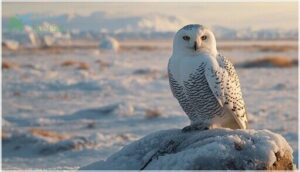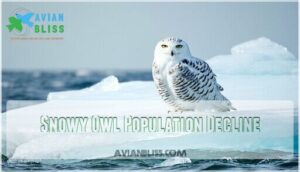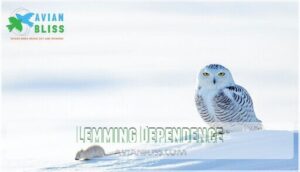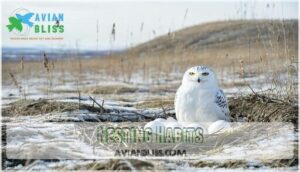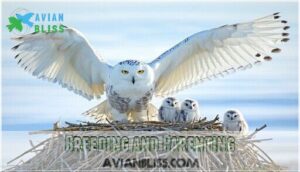This site is supported by our readers. We may earn a commission, at no cost to you, if you purchase through links.

Right now, the snowy owl isn’t officially listed as endangered, but scientists have noticed its numbers are dropping.
The IUCN labels it as “Vulnerable,” meaning it’s at risk if things don’t improve.
Researchers blame climate change, shrinking lemming populations (their favorite snack), and habitat loss.
Recent estimates suggest fewer than 30,000 adults remain worldwide.
You’ll see them less often in southern areas, especially if winters are mild.
So, while you don’t need to sound the alarm just yet, the snowy owl’s story has a few twists worth exploring in the sections ahead.
Table Of Contents
- Key Takeaways
- Is The Snowy Owl Endangered?
- Snowy Owl Population Decline
- Lemming Dependence
- Climate Change Impact
- Snowy Owl Biology and Behavior
- Cultural Significance
- Conservation Efforts
- Observing Snowy Owls
- Population Estimates
- Frequently Asked Questions (FAQs)
- Are snowy owls endangered?
- Are snowy owls dangerous?
- Are snowy owls overestimated?
- What are the threats to the snowy owl?
- Are snowy owls rare?
- How many snowy owls are left?
- How many Snowy Owls are left in the world in 2025?
- Are owls still endangered?
- Are Snowy Owls endangered in Canada?
- Are snowy owls endangered in 2024?
- Conclusion
Key Takeaways
- You’re looking at a species that’s currently listed as "Vulnerable" by the IUCN, not endangered yet, but they’re walking a tightrope with populations that could push them into endangered status if current trends continue
- You’ll find their numbers have crashed dramatically—from 200,000 individuals in 2013 to just 28,000 by 2018, with fewer than 30,000 adults remaining worldwide today
- You can’t separate their survival from climate change since they depend almost entirely on lemmings (90% of their diet), and warming temperatures are disrupting these prey cycles that snowy owls need to breed successfully
- You can help protect them by maintaining proper viewing distances, supporting collision mitigation efforts, and backing conservation programs that focus on preserving Arctic habitats and reducing human disturbance at roosting sites
Is The Snowy Owl Endangered?
Currently, snowy owls aren’t classified as endangered, but they’re walking a conservation tightrope. The International Union for Conservation of Nature lists them as "vulnerable species" since 2017, marking significant population decline and conservation urgency.
These Arctic hunters are teetering on the edge, with populations crashing from 200,000 to just 28,000 in five short years.
This vulnerable species status means they’re one step away from endangered classification, with uplisting risks increasing if current trends continue. Population viability studies reveal alarming drops from 200,000 to just 28,000 individuals between 2013 and 2018.
North American populations have plummeted 64% since the 1960s, triggering habitat threats concerns across their Arctic range. Scientists warn that continued owl population decline could push these magnificent birds toward endangered species status within years.
The future outlook depends heavily on snowy owl conservation efforts addressing climate change impacts on their lemming prey base. Without intervention, these Arctic hunters face an uncertain tomorrow.
Snowy Owl Population Decline
The snowy owl’s population has plummeted dramatically, dropping from 200,000 individuals in 2013 to just 28,000 by 2018.
This steep decline prompted the IUCN to classify the species as Vulnerable in 2017, with scientists warning that continued losses could push these Arctic hunters toward Endangered status.
IUCN Status
Looking at the snowy owl’s conservation status reveals concerning trends that demand immediate attention.
The IUCN Red List officially classifies these Arctic predators as Vulnerable since 2017, marking a significant shift from their previous "Least Concern" designation.
This vulnerable listing reflects documented population declines exceeding 30% over three generations, with current estimates placing the global breeding population at just 14,000-28,000 adults.
If current trends continue, endangered uplisting becomes increasingly likely, highlighting urgent conservation implications for this iconic species.
The owl’s decline is partly attributed to Arctic warming trends impacting prey.
Adult Population Decrease
Recent studies reveal a shocking drop from 200,000 to just 28,000 mature individuals globally.
This dramatic population decline highlights estimation challenges that previously led to historic overestimation.
Regional declines across North America show breeding pairs facing unprecedented threats, making snowy owl status increasingly precarious as this vulnerable species requires urgent conservation efforts against climate change impact.
Snowy owls are known for their diurnal hunting behavior, especially during Arctic summers.
Potential Endangered Status
The IUCN warns that continued population decline could push snowy owls from vulnerable to endangered status.
Uplisting Factors include habitat loss and climate change impacts.
Decline Thresholds show Regional Differences—Norway already lists them as endangered with fewer than 50 individuals.
Conservation Urgency grows as Future Projections suggest further losses without immediate action.
- Scientists fear we’re watching a Arctic icon slip toward extinction
- Every delayed conservation effort brings these magnificent hunters closer to disappearing forever
- Your children might only see snowy owls in books if current trends continue
Owl Research Institute (ORI) Findings
The Owl Research Institute operates North America’s longest-running snowy owl study since 1992 in Alaska.
Their long-term studies reveal dramatic population decline patterns through systematic ORI methodologies. Data interpretation shows breeding success directly correlates with lemming availability.
Holt’s conclusions emphasize that climate change disrupts traditional prey cycles, making future research critical.
These conservation efforts provide essential baseline data for protecting Arctic ecosystems and understanding predator-prey relationships.
Their wintering range extends to southern Canada, where they seek open fields.
Lemming Dependence
You’ll find that snowy owls depend almost entirely on lemmings, which make up 90% of their diet and require them to consume 3-5 lemmings daily during peak seasons.
When lemming populations crash in their natural 3-4 year cycles, snowy owl breeding success plummets dramatically, creating a direct link between prey availability and owl survival.
Prey Composition
When lemming abundance peaks, snowy owls consume 3-5 lemmings daily, making up 90% of their diet.
However, diet variation becomes essential during lean periods.
Their hunting strategies adapt to pursue alternative prey including Arctic hares, ptarmigan, ducks, and fish.
This flexibility in prey availability helps sustain populations when lemming cycles decline, though prey quality varies substantially across different food sources.
Lemming Population Cycles
Understanding lemming cycles helps you grasp why snowy owls face population decline. These Arctic rodents follow predictable 3-4 year boom-bust patterns that directly impact owl survival and reproduction success.
Climate influence disrupts traditional cycles through:
- Snowmelt effects – Rain-on-snow events create ice barriers that block lemming access to vegetation
- Predation impact – Specialist predators like weasels regulate cycle amplitude and timing
- Cycle causes – Winter reproduction capacity determines outbreak potential each season
- Habitat fragmentation – Warming temperatures force lemmings northward, reducing available food source areas
Industrialization can further exacerbate these issues, as mining destroys habitats.
Lemming Habitat Changes
Arctic warming transforms the delicate balance that lemmings depend on for survival.
Snowmelt impact creates unpredictable conditions—too much melt exposes them to predators, while insufficient snow limits access to vegetation beneath.
| Climate Factor | Impact on Lemmings |
|---|---|
| Arctic warming | Disrupts traditional snow patterns |
| Vegetation shifts | Reduces available food sources |
| Disease prevalence | Increases in warmer, wetter conditions |
| Habitat fragmentation | Breaks up continuous lemming territories |
These habitat loss changes directly affect snowy owls through population decline, as their primary food source becomes increasingly unstable across the Arctic tundra.
Climate Change Impact
You’re witnessing one of the most significant conservation challenges facing Arctic wildlife today.
Climate change directly threatens snowy owls through temperature increases that disrupt their entire ecosystem, from prey availability to nesting conditions.
ORI Research
For over thirty years, the Owl Research Institute has collected thorough data on snowy owl breeding patterns and lemming populations near Utqiaġvik, Alaska.
Their research methods involve annual nest monitoring and intensive prey surveys, providing vital data collection for conservation efforts.
This long-term study directly addresses Holts Hypotheses about climate impacts, with findings informing future research on these vulnerable Arctic species.
Weather Data Analysis
Building on ORI’s research findings, Weather Data Analysis reveals how changing conditions affect snowy owls through thorough monitoring systems.
Scientists track multiple environmental factors to understand Climate change impacts on Arctic ecosystems where Snowy owls depend on stable conditions. Climate change also impacts bird migration patterns.
Climate Modeling shows four critical Temperature Trends affecting owl populations:
- Snow Cover instability – Irregular freeze-thaw cycles damage lemming habitat structures
- Precipitation Patterns shifts – Increased rainfall creates ice barriers blocking prey access
- Arctic Oscillation changes – Altered wind patterns disrupt traditional weather cycles
- Environmental changes acceleration – Rapid Global warming outpaces species adaptation rates
Indirect Effects on Owls
Climate change creates a domino effect for snowy owls through habitat degradation and prey scarcity.
When temperatures rise, lemming populations crash, leaving owls without their primary food source.
Ecosystem imbalance follows as pollution impacts and disease transmission increase.
Environmental threats multiply when you’re dealing with melting permafrost and shifting vegetation patterns.
These cascading effects make conservation efforts critical for preventing habitat loss.
Snowy Owl Biology and Behavior
Understanding snowy owl biology reveals why these Arctic predators face such vulnerability in our changing world.
Their specialized adaptations, from dense feather insulation to nomadic breeding patterns, make them perfectly suited for harsh tundra conditions.
But they are increasingly challenged by environmental shifts, which threaten their very existence due to these adaptations.
Physical Description
The snowy owl’s striking appearance makes it one of nature’s most recognizable Arctic predators.
These magnificent birds display remarkable plumage variation, with males becoming nearly pure white while females retain dark barring throughout their lives.
Their size dimorphism is notable, as females outweigh males substantially.
- Feather density provides exceptional insulation against temperatures reaching -40°F
- Facial disc structure enhances hearing precision for detecting prey beneath snow
- Talons shape features curved, razor-sharp claws perfect for grasping slippery prey
Nesting Habits
Unlike the intricate appearance of their feathered bodies, snowy owls keep nesting surprisingly simple.
These Arctic birds don’t construct elaborate homes—they scrape shallow depressions directly into tundra ground. You’ll find their nest sites on elevated ridges where visibility spans miles, helping spot approaching predators or locate abundant lemmings below.
Their nest site selection is influenced by factors like protection from predators.
| Nesting Feature | Arctic Tundra | Elevated Sites |
|---|---|---|
| Nest Structure | Ground scrape | 2-4 inches deep |
| Site Selection | Open areas | Rocky outcrops |
| Territory Size | 1-2 square miles | Variable by food |
| Clutch Protection | Minimal cover | Strategic positioning |
| Success Factors | Lemming availability | Weather conditions |
This minimalist approach works perfectly—the female’s camouflaged plumage blends seamlessly with surrounding vegetation while she incubates eggs.
Breeding and Parenting
During Arctic breeding, female snowy owls lay clutches of 3-11 eggs in ground scrapes.
Males provide constant food while females incubate for 32 days.
Breeding success depends heavily on lemming abundance, with chick survival requiring intense parental care.
Nesting behavior includes:
- Fierce territorial defense against intruders
- Continuous hunting by males to feed growing broods
- Aggressive protection of vulnerable chicks
- Strategic nest placement on elevated tundra sites
Dietary Requirements
You’ll find that snowy owls are voracious predators with impressive nutritional needs. These Arctic hunters consume up to one pound of prey daily, with lemmings serving as their primary food source – making up 90% of their diet.
Their hunting strategies include hovering, walking, and using exceptional sight and hearing. Prey availability directly impacts their survival, as owls require 3-5 lemmings daily during population booms.
Diet variation occurs seasonally, incorporating hares, ptarmigan, ducks, and fish when lemming cycles crash. This adaptability within the Arctic food chain helps snowy owls survive harsh conditions, though their dependence on specific owl food sources makes them vulnerable to environmental changes.
Cultural Significance
You’ve probably spotted a snowy owl in art, books, or movies without realizing these Arctic hunters carry deep cultural meaning across many societies.
From Inuit legends to Harry Potter’s Hedwig, snowy owls have captured human imagination for centuries, symbolizing wisdom, mystery, and the wild beauty of northern landscapes.
Folklore and Literature
Throughout countless cultures, snowy owls appear as powerful symbols in folklore and literature.
These Arctic species vulnerability hasn’t diminished their mythical powers in storytelling.
You’ll find cultural depictions spanning continents:
- Ancient legends from Inuit communities describe snowy owls as spiritual guides whose calls direct hunters through blizzards
- Literary appearances like Hedwig in Harry Potter showcase owl symbolism representing wisdom, loyalty, and magical connection
- Mythical powers attributed to these vulnerable birds include weather prediction and communication between worlds in various traditions
Occasional Southern Movements
Snowy owls undergo dramatic population shifts called irruptions, where thousands suddenly appear across the northern United States during winter months.
These migration triggers stem from lemming crashes in the Arctic, forcing owls to seek alternative prey farther south.
Climate change disrupts traditional winter range patterns, pushing birds into unfamiliar territories. You’ll spot them in open fields and airports, adapting their hunting strategies for new environments.
Southern adaptations include targeting different prey like waterfowl and small mammals. However, survival rates decrease substantially outside their Arctic home.
Conservation efforts focus on protecting these temporary southern habitats during irruption years, ensuring safe passage for these remarkable Arctic visitors.
Long-distance Migration
You’ll witness remarkable winter wanderers covering up to 7,000 miles during their Arctic migration.
These snowy owls don’t follow predictable migration routes like other birds. Instead, migration triggers depend entirely on lemming populations in their Arctic range.
When prey becomes scarce, survival challenges force them into irruptive movements across vast winter ranges. Their navigation methods remain mysterious, but climate change increasingly disrupts these ancient migration patterns.
Conservation Efforts
You can protect snowy owls through three key conservation strategies that address their most pressing survival challenges.
These efforts focus on reducing human disturbance at roosting sites, preventing deadly collisions with vehicles and power lines, and preserving critical Arctic breeding habitats from climate change impacts.
Disturbance Reduction
Beyond their cultural importance, snowy owls need your help reducing human disturbance. You’ll protect these endangered birds by maintaining proper viewing distance of 100 yards minimum.
Noise pollution from crowds seriously impacts their habitat sensitivity, so keep voices low. Responsible tourism means avoiding flash photography and staying on designated paths.
Ethical photography requires telephoto lenses instead of close approaches. Utilizing a specialized owl lens can help capture stunning images without disturbing these creatures.
Conservation efforts focus on buffer zones around nesting sites, protecting owls from unnecessary human impact during critical breeding periods, which is crucial for their breeding periods.
Collision Mitigation
Preventing snowy owl fatalities requires thorough collision mitigation strategies.
Airport wildlife management programs relocate owls from runways, reducing airplane strikes. Transportation authorities install wildlife crossing structures and warning systems to minimize vehicle strikes. Managing airport bird control is vital for safety.
Key collision mitigation approaches include:
- Airport monitoring – Staff track owl movements near runways during peak migration periods
- Power line modifications – Utility companies install bird-safe equipment to prevent electrocutions
- Wind turbine placement – Strategic siting avoids major flyways and migration corridors
- Road design improvements – Wildlife underpasses and fencing guide owls away from traffic
These targeted interventions substantially reduce human-caused mortality in snowy owl populations.
Habitat Protection
Protecting Arctic habitats requires broad conservation strategies that address multiple threats.
Protected areas safeguard critical nesting sites from habitat destruction, while landscape-scale initiatives preserve breeding grounds across the snowy owl’s range.
Here’s how habitat protection works:
- Protected Areas – Establish reserves around key nesting sites to prevent habitat loss
- Reduce Disturbances – Create buffer zones that minimize human interference during breeding
- Arctic Conservation – Partner with Indigenous communities for traditional land stewardship
- Habitat Preservation – Maintain healthy lemming populations through sustainable land management
These efforts directly combat owl habitat loss while supporting the entire Arctic ecosystem.
Observing Snowy Owls
Spotting snowy owls requires patience and respect, especially since these vulnerable Arctic visitors are already facing significant population pressures.
You’ll want to observe from a distance using binoculars or a spotting scope, watching for behavioral cues like head swiveling, wing stretching, or hunting postures that indicate the owl’s comfort level with your presence, which is crucial for a successful and respectful observation.
Respectful Viewing
When observing Snowy Owls, practice Ethical Birding by maintaining at least 100 feet distance to Minimize Impact.
Use your vehicle as a blind and move slowly. Watch for Disturbance Signs like alert posturing or flight responses.
Responsible Photography means no flash or close approaches that stress these magnificent birds. For enhanced viewing, consider using specialized birding equipment.
Supporting Wildlife Conservation through respectful viewing helps protect their fragile Habitat and prevents these vulnerable owls from becoming Endangered.
Behavioral Cues
When spotting snowy owls, you’ll recognize their comfort level through specific behavioral cues that reveal their hunting strategies and social behavior.
- Relaxed posture – feathers lie flat against their body, indicating they’re not threatened by predators
- Half-closed eyes – this drowsy expression shows they’re conserving energy between hunting sessions
- Calm head movements – slow, deliberate turns while scanning for lemmings or other prey
- Preening activities – grooming behavior demonstrates they feel secure in their current location
These signs help you distinguish between stressed and content snowy owls during observation.
Minimizing Disturbance
When observing snowy owls, stay at least 100 yards away to prevent nesting disruption.
Respectful viewing means no flash photography or sudden movements that stress these endangered birds.
Responsible photography supports conservation by showcasing their beauty without harm.
Ethical birding practices protect habitat protection efforts and reduce wildlife threats.
Your distance shows respect for species protection.
Population Estimates
Understanding snowy owl population numbers helps you grasp the severity of their conservation crisis.
Current estimates reveal dramatic declines that have shifted this Arctic species from abundant to vulnerable in just a few decades.
Global Population
Scientists estimate the global snowy owl population at just 14,000–28,000 breeding pairs, a dramatic drop from previous estimates of 290,000.
Climate change and prey decline drive this concerning trend across their habitat range.
Key population distribution facts:
- Current conservation status: Vulnerable on IUCN Red List since 2017
- Population estimation challenges due to nomadic movement patterns
- Breeding pairs scattered across circumpolar Arctic regions
- Population threats include lemming decline and collision mortality
- Endangered classification possible if declines continue at current rates
North American Population
Most North American Snowy Owls face declining populations, with fewer than 30,000 individuals remaining across their range.
These Arctic specialists struggle with habitat loss and shifting migration patterns that directly impact breeding success.
- Population estimation: Fewer than 30,000 individuals across North America
- North American range: Primarily Canadian Arctic and Alaska tundra
- Conservation status: Vulnerable classification due to steep decline causes
- Migration patterns: Unpredictable movements based on prey availability
Population Trends
Population trends reveal alarming changes for snowy owls.
Population decline has dropped numbers from 200,000 to 28,000 since 2013.
The IUCN classification shifted from Least Concern to Vulnerable in 2017.
Breeding pairs now total just 14,000 globally.
Regional variations show North America’s 64% decrease since the 1960s.
Habitat loss and climate change drive these population fluctuations, threatening snowy owl numbers with potential endangered status.
Frequently Asked Questions (FAQs)
Are snowy owls endangered?
Snowy owls aren’t endangered yet, but they’re getting close. You’ll find them listed as "Vulnerable" on conservation lists, with populations dropping from 200,000 to just 28,000 since 2013—that’s concerning stuff.
Are snowy owls dangerous?
Picture yourself walking across a snowy field when you spot a magnificent white owl perched nearby.
You’re perfectly safe—snowy owls aren’t dangerous to humans.
They’re actually quite shy and prefer avoiding people altogether, focusing on hunting small prey like lemmings instead.
Are snowy owls overestimated?
Yes, you’re right that snowy owl populations were historically overestimated.
Scientists now realize they mistakenly double-counted these nomadic birds across their vast ranges, leading to inflated population figures of up to 290,000 when actual numbers are 14,000-28,000, which is a significant difference due to the nomadic birds.
What are the threats to the snowy owl?
Climate change threatens you’ll see fewer snowy owls as warming temperatures disrupt lemming populations—their primary food source.
Vehicle collisions, power line strikes, and habitat loss from human development create additional survival challenges for these Arctic hunters.
Are snowy owls rare?
Unfortunately, you’ll find these Arctic hunters facing tough times—their population dropped dramatically from 200,000 to just 28,000 individuals between 2013 and 2018, making them quite rare today.
How many snowy owls are left?
Current global estimates put snowy owl numbers between 14,000-28,000 mature individuals worldwide. You’re looking at roughly 7,000-14,000 breeding pairs scattered across Arctic regions, representing an 86% decline from 2013’s 200,000 estimate.
How many Snowy Owls are left in the world in 2025?
Like tracking snowflakes in a blizzard, you’ll find approximately 14,000 to 28,000 snowy owls remain worldwide in 2025, down from 200,000 in 2013, making them vulnerable to extinction.
Are owls still endangered?
Snowy owls aren’t endangered yet, but they’re vulnerable with declining populations.
You’ll find their status varies by region – some areas classify them as threatened due to climate change affecting their Arctic habitat and lemming prey availability.
Are Snowy Owls endangered in Canada?
In Canada, you’ll find snowy owls classified as "Threatened" by COSEWIC since 2018, though federal and provincial governments haven’t officially adopted this designation yet despite significant population declines.
Are snowy owls endangered in 2024?
You’ll find snowy owls aren’t officially endangered yet, but they’re vulnerable. Their population dropped dramatically from 200,000 to 28,000 between 2013-2018, making conservationists worried they’ll need endangered status soon.
Conclusion
Understanding whether the snowy owl is endangered reveals a complex conservation story.
Currently, these Arctic hunters aren’t officially endangered, but their "Vulnerable" IUCN status signals genuine concern.
With fewer than 30,000 adults remaining globally, declining lemming populations, and climate change disrupting their breeding cycles, you’re witnessing a species at a critical crossroads.
Conservation efforts focusing on habitat protection and collision reduction offer hope, but the question "is the snowy owl endangered" may require a different answer sooner than expected, due to the significant impact of declining lemming populations.
- https://www.tnonline.com/20250308/hawk-mountain-biologist-leads-snowy-owl-study/
- https://www.projectsnowstorm.org/posts/first-ever-global-status-assessment-for-snowy-owls-raises-red-flags/
- https://chasingnature.substack.com/p/snowy-owls-in-decline
- https://www.rmoutlook.com/the-latest/snowy-owls-threatened-status-an-alarm-bell-for-a-changing-arctic-scientist-says-10709065
- https://www.smithsonianmag.com/science-nature/snowy-owl-disappearing-180970314/

